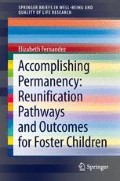Abstract
Caseworkers were asked to identify the difficulties they believed contributed to children’s entry into care. For the majority of families multiple factors contributed to the decision to place a child in care. It was less likely for caseworkers to attribute placement to a single factor when multiple factors were identified both primary and secondary reasons acted together to trigger trajectories into care. Child neglect is the main reason leading to entry into a temporary family care program, followed closely by substance misuse by parents. Caseworkers identified all forms of child abuse, physical, emotional and sexual, as reasons children came into care. The reasons implicated in bringing children into care in this chapter are employed in Chap. 6 as predictive factors in an analysis of reunification patterns and outcomes.
Access this chapter
Tax calculation will be finalised at checkout
Purchases are for personal use only
References
Abel, G. G., Becker, J. V., Mittelman, M. S., Cunningham-Rathner, J., Rouleau, J. L., & Murphy, W. D. (1987). Self-reported sex crimes of non-incarcerated paraphiliacs. Journal of Interpersonal Violence, 2(1), 3–25.
Beckett, C., McKeigue, M., & Taylor, H. (2007). Coming to conclusions: Social work perceptions of the decision-making process in care proceedings. Child and Family Social Work, 12(1), 54–63.
Beckett, C., & McKeigue, M. (2003). Children in Limbo: Case where care proceedings have taken two years or more. Adoption and Fostering, 27(3), 31–40.
Doyle, C. (1995). Helping strategies for child sexual abuse. Maidenhead: Whiting and Birch Ltd (in association with the National Children’s Bureau).
Faller, K. C. (2002). Understanding and assessing child sexual maltreatment. Newbury Park, CA: Sage Publications.
Fernandez, E. (1996). Significant harm: Unravelling child protection decisions and substitute care careers of children. Avebury, England: Ashgate Publishing.
Festinger, T. (1996). Going home and returning to foster care. Children and Youth Services Review, 18(4/5), 383–402.
Forrester, D., Harrison, J. (2008). Parental substance misuse and child welfare: Outcomes for children two years after referral. British Journal of Social Work, 38(8), 1518–1535.
Higgins, D. J., & McCabe, M. (2001). Multiple forms of child abuse and neglect: Adult retrospective reports. Aggression and Violent Behavior, 6(6), 547–578.
Maluccio, A. N., Ainsworth, F. (2003). Drug use by parents: A challenge for family reunification practice? Children and Youth Services Review, 25(7), 511–533.
O’Hagan, K. (1993). Emotional and psychological abuse of children. Toronto: University of Toronto Press.
Tomison, A. M., & Tucci, J. (1997). Emotional abuse: The hidden form of maltreatment, NCPCH Issues Paper no.8, AIFS, Melbourne.
Author information
Authors and Affiliations
Corresponding author
Rights and permissions
Copyright information
© 2013 Springer Science+Business Media Dordrecht
About this chapter
Cite this chapter
Fernandez, E. (2013). Reasons for Children Entering Care. In: Accomplishing Permanency: Reunification Pathways and Outcomes for Foster Children. SpringerBriefs in Well-Being and Quality of Life Research. Springer, Dordrecht. https://doi.org/10.1007/978-94-007-5092-0_3
Download citation
DOI: https://doi.org/10.1007/978-94-007-5092-0_3
Published:
Publisher Name: Springer, Dordrecht
Print ISBN: 978-94-007-5091-3
Online ISBN: 978-94-007-5092-0
eBook Packages: Humanities, Social Sciences and LawSocial Sciences (R0)

